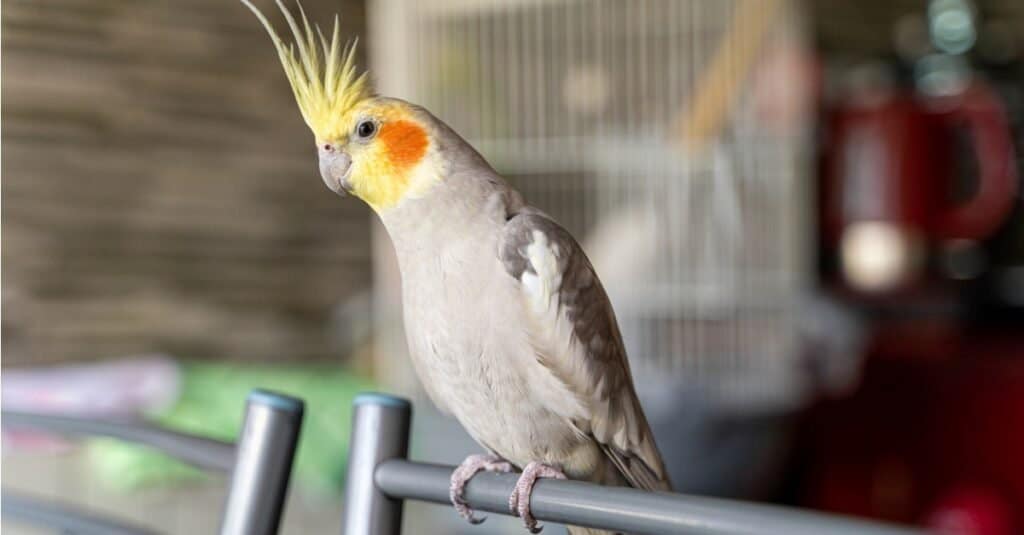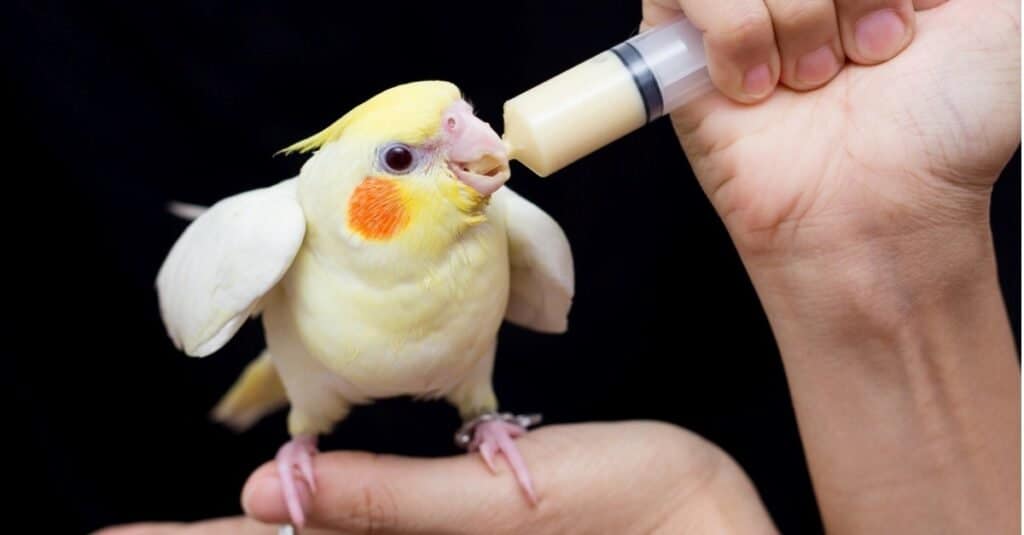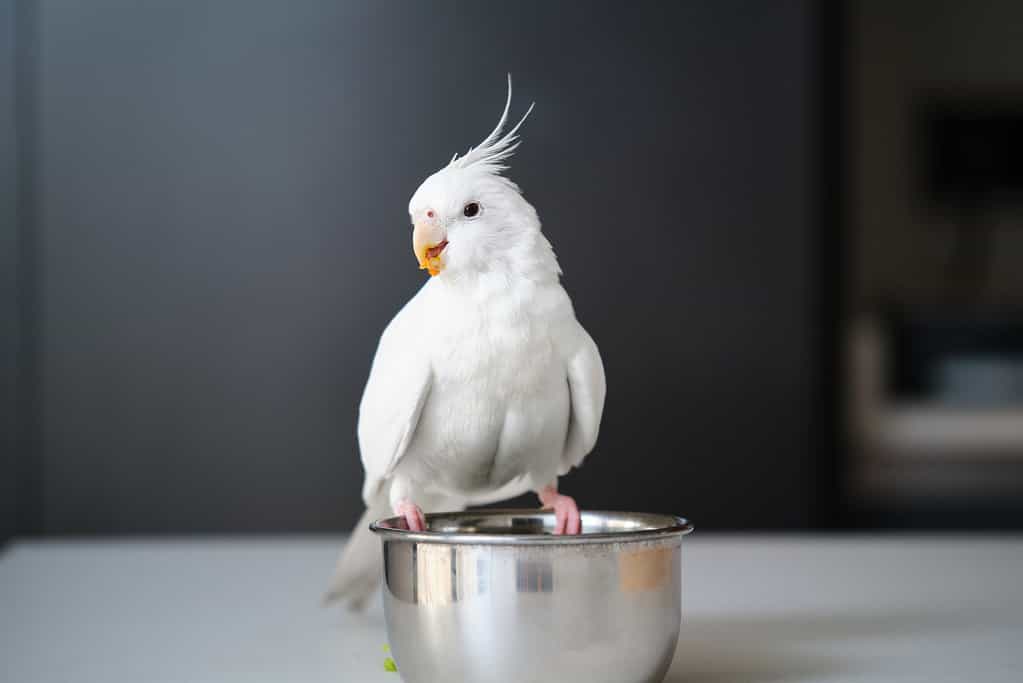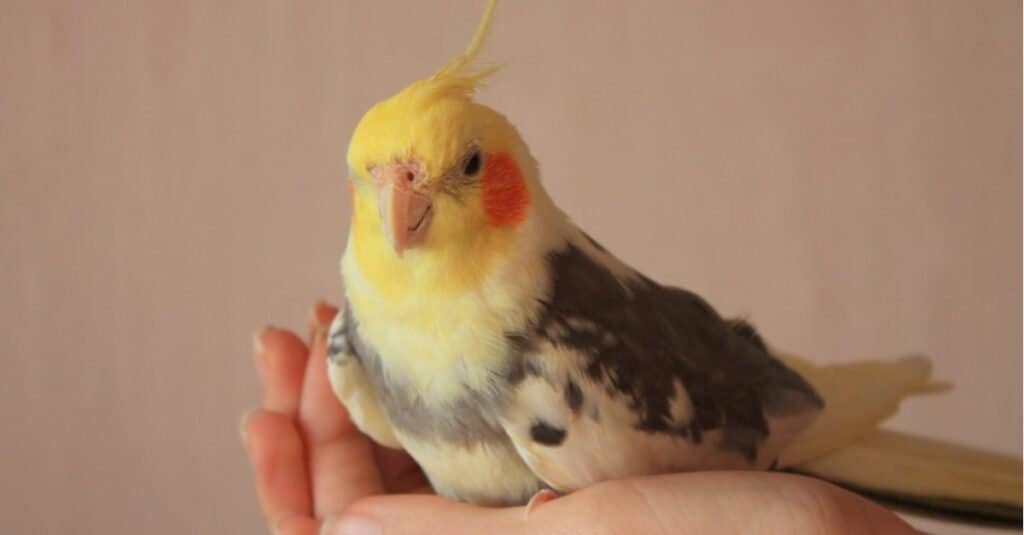Cockatiels, Nymphicus hollandicus, are medium-sized parrots. Comical, intelligent, and curious, cockatiels are one of the most sought-after pet birds. They are known for their friendly disposition and ability to learn tricks and mimic sounds. Wild cockatiels live in the semi-arid regions of Australia, including bushlands, scrublands, and wetlands. They have a crested head and various colorations. A well-cared-for cockatiel can live to be 10-15 years old. Are you considering owning one of these charming pet birds? Here’s an in-depth introduction to owning a cockatiel, plus a complete care guide.

Owning a cockatiel can be rewarding when you know basic techniques for their care and training.
©iStock.com/PaulGulea
Cockatiel Temperament: Social Behavior and Traits
Cockatiels are affectionate and can be excellent companions. They are curious, crave daily interaction with people or other birds, and enjoy playing with toys and stretching their wings. With gentle and consistent handling, cockatiels often grow strong bonds with their owners.
A cockatiel’s head crest can tell you a lot about their feelings. When a cockatiel’s crest is flattened significantly, especially if it retreats or hisses, it indicates it feels stressed or threatened. A startled or curious cockatiel will hold its crest feathers straight up. In contrast, a relaxed cockatiel will have fluffed-up cheek feathers with a partially upright crest, often accompanied by a soft grinding noise.
Hand-fed cockatiels are an excellent choice for first-time bird owners or anyone seeking a cockatiel who will enjoy hanging out on or near their owner. Feeding baby chicks every few hours takes dedication and training. Hand-feeding is done during the first month of a chick’s life by an experienced breeder who knows their nutritional needs. Hand-fed cockatiels learn to trust people and eagerly climb onto their hands. These birds can be more expensive, but they are excellent pets.

Hand-fed cockatiel chicks are friendly and tend to trust humans.
©iStock.com/tatchai
Cockatiel Diet: Nutritious Feeding Guide
The ideal way to feed a cockatiel is by providing a mixed diet of fresh food, seeds, and pellets. The best diet consists primarily of pellets, which are balanced with essential nutrients. Fresh fruits and vegetables are another vital source of nutrients for cockatiels. Your bird might prefer seeds over other foods, but birds who eat an all-seed diet can suffer from mineral and vitamin deficiencies. Moreover, seeds are high in fat, which can lead to liver disease.
Curious by nature, many cockatiels enjoy nibbling on their owner’s meals. However, there are some foods you should avoid letting your cockatiel eat. Avocados, salt, coffee, and chocolate are toxic to birds and should never be given to a cockatiel.
Wild cockatiels forage for food on the ground. One way to mimic this behavior is to sprinkle seeds or a treat like millet on the floor of a cage. In addition, you can offer treats on the ground or on a table when your cockatiel is out of its cage. Engaging in foraging will increase their quality of life by providing the mental and physical challenges they would typically get in the wild.
Female cockatiels need extra calcium and other vitamins. They do not need a male companion to lay eggs — they will produce infertile eggs even when housed alone. They need supplemental calcium to offset the vitamins and minerals lost during egg production. Cuttlebones or calcium supplements are a great addition to your female cockatiel’s diet.
Complete Cockatiel Care: Housing, Grooming, and Health
Housing
Since cockatiels spend most of their time in a cage, the primary consideration when bringing a cockatiel home is its cage size. Larger cages give cockatiels room to stretch and fly, which will help them get exercise. At a minimum, they need enough space to flap their wings without hitting the sides of the cage. The largest cage you can provide is the best — width matters more than height as it gives them room to stretch.
Cockatiels like to chew on things, so metal is the best option when choosing a cage. Decorative wood cages are not suitable for cockatiels. The maximum opening between bars should be 3/4 of an inch. Otherwise, your cockatiel could get its head stuck between bars.
Stainless steel is an excellent choice for food and water dishes. The best place for food and water containers is somewhere that is not directly under a perch, which will keep them free of feces. An excellent food dish option is foraging trays — small containers filled with non-edible materials like pine cones or shredded paper, along with edible seeds, pellets, or treats. The idea is to engage your bird’s natural foraging instincts while they eat. Small organizing trays or metal baking trays work well as foraging containers.
Exercise
Exercise is an essential factor in keeping your cockatiel healthy. Above all, cockatiels love to play, so adding perches, toys, and mirrors to their cage will keep them entertained. These activities keep your bird physically and mentally healthy. Additionally, they need room to roam and stretch, so toys should not hinder their ability to move in their cage. Non-toxic wood toys, paper toys, and toys with cuttlebones are excellent choices for keeping your bird’s beak busy.
Interacting with their owners or other birds is vital for a cockatiel’s mental health. They are social animals and will benefit from activities like sitting on your shoulder, gently being pet, sitting near you, and even listening to you speak or whistle to them. Ideally, they need at least one solid hour of daily interaction with their owners.
Grooming
Grooming a cockatiel is easy compared to many pets. Most cockatiel care guides recommend offering a shallow bowl of water two to three times per week — hopefully, your bird will willingly take a bath. Weekly baths reduce the dust on your cockatiel’s body and even help keep it out of the air in your home. If your cockatiel doesn’t like shallow baths, you can use a spray bottle to gently shower your bird.
Cement perches or perches with sandpaper covers keep your bird’s nails from getting too long. Similarly, offering cuttlebones and hardwood toys encourages your cockatiel to chew, which will help keep its beak from getting overgrown. Avian veterinarians know how to trim birds’ beaks.
Hygiene
You can reduce your cockatiel’s risk of health problems by creating a regular cage-cleaning schedule. It’s best to keep perches, toys, and the grill on the bottom of the cage free of bird droppings. The easiest way to stay on top of hygiene is to wipe down everything once a day and then do a deep cleaning of the cage once a month. Remove unused fresh foods before they spoil, which can happen in as little as an hour. Water bowls and food dishes should be washed daily with hot water and dish soap.
Sunlight
Sunlight and fresh air are essential for your cockatiel. Like humans, cockatiels need exposure to sunlight so that their bodies can produce vitamin D. Exposing them to sunlight for at least 30 minutes per day will significantly impact their health. Some owners take their bid’s cage outdoors for a few hours daily or position it in a sunny spot indoors. Consideration should also be given to outdoor temperatures and drafts — cockatiels don’t do well in extreme temperatures or cold drafts. As a last resort, you can give your cockatiel vitamin D supplements if you can’t provide direct sunlight.
Cockatiel Colorations
Over time, professional bird breeders have successfully developed a variety of cockatiel color mutations. Cockatiels are available in a range of patterns and colorations. Here’s a look at some of the most common color variations.

An albino cockatiel lacks the bright cheek color and feather pigmentation.
©Ladanifer/iStock via Getty Images
- Grey Cockatiel: This is the most common color variety, also known as a “standard” cockatiel. Includes dark grey body feathers and white or pale-yellow markings on their wings and tail.
- Pearl: A spotting of lighter colorations creates a scalloped pattern on the body of a pearl-colored cockatiel.
- White-Faced Cockatiels: This color mutation results in a bird that lacks the standard orange cheek patch. These birds are light colored with streaks of grey feathers and a white mask on their face.
- Albino: These cockatiels are entirely white because of a lack of feather pigmentation.
- Lutino: These all-white birds have a yellow mask, orange cheeks, and red eyes.
- Pied: A pied cockatiel has dark grey body feathers like the grey cockatiel but with light-colored patches where melanin is absent.
- Cinnamon: Also known as a fawn coloration, these birds have grey feathers that appear brown or warm tan.
- Silver: Their body is a light silvery grey, and they have red eyes.
- Olive: Also known as an emerald mutation, these cockatiels have light grey feathers with a yellow undertone, giving them a greenish appearance. They also have a unique spangled pattern because of the variation in tones throughout their feathers.
Training and Bonding with Cockatiels: Tips for a Strong Relationship
Cockatiels are keen observers. As a result, they learn tricks, mimic sounds, and respond to commands when handled regularly. These tips will help you foster a strong relationship with your cockatiel. The key to owning a happy cockatiel is providing various activities that satisfy their intense curiosity.
Tips for Bonding with Your Bird
- Slow Movements — Build trust and security with slow movements. Moving slowly around your cockatiel will keep them from being startled.
- Music — Singing and whistling to your cockatiel is an easy way to bond with them. Cockatiels enjoy imitating sounds, and they love being serenaded. While some cockatiels can learn to talk, they prefer imitating whistles.
- Treats – Offering your cockatiel their favorite treat is a proven technique for bonding. For some cockatiels, fruits and vegetables are irresistible. The most common favorite treats tend to be sunflower seeds and millet.
- Toys and Activities — Placing toys in your bird’s cage shows them you care. Cockatiels enjoy shredding paper toys and hunting for tasty treats on foraging toys. If you place these toys in their cage, they see it as a positive gesture.
- Quality Time — The most powerful way to show your cockatiel that you are not a threat is to spend time near them daily. Using a method called passive interaction can dramatically increase the bond you have with your bird. Passive interaction is simple — sit near the cockatiel’s cage for an hour or more daily without trying to interact with them.

Cockatiels are social birds who will bond with people they trust.
©iStock.com/sapozhnik
Spending quality time bonding with your cockatiel is a rewarding investment. Over time, your cockatiel will show signs that they trust you, including greeting you with whistling and chirps, happily preening themselves when you are near, taking food directly from your hands, and bowing their head to you so that you can scratch them. With love and patience, your cockatiel will give you years of entertainment and companionship.
The photo featured at the top of this post is © Kelly2357 / CC BY-SA 3.0 – License / Original
Thank you for reading! Have some feedback for us? Contact the AZ Animals editorial team.






